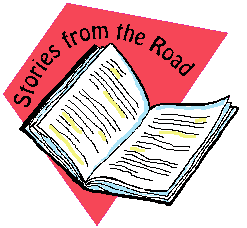|
Toasting the Napa Valley(Filed from Napa, California at 12:40 p.m. on August 20, 1999) Wine. Vine. Sunshine. Well, perhaps not in that order but if you throw in a few grapes on the vine, add in copious amounts of sunshine and wait several months, you're likely to get some marvelous wine, at least in Northern California's Napa Valley. Fen and I pay a visit to this quintessential American wine-making region in search of lazy days and star-kissed nights...and a mean Merlot. Our first stop is Swanson Vineyards, which we heard about while having dinner at The Painted Table in Seattle. Our waiter had brought over a bottle of Swanson Rosato, a "blush wine," as he had called it. "Ro-zay," Fen muttered under his breath. To make matters worse, our waiter offered the following tidbit: the Swanson winery was founded by the same Swansons who did fish cakes and fish sticks. I shuddered -- until I tasted the wine. "Incredible," I said to Fen, and after a sip of his own he was eating (make that gulping) his words. "Yep, blush wines are making a comeback," our waiter continued, "and the Swanson is one of the best." Fen and I knew then and there that we had to go to the source. We arrive at Swanson Vineyards on a late Friday morning and are greeted by Marco Capelli, resident winemaker. Movie-star handsome, I can't help but notice that Marco's curly black hair is the perfect complement to his sun-bronzed skin. A latter-day David, but with much better color than the Florentine dream. I snap out of it and remind myself that I'm here to learn about wine. While Swanson doesn't offer tours of its vineyard to the public, they do have a spanking-new tasting room available for those in search of a sip or two (and a purchase or three). Marco gives us some facts and figures to start things off: Clark and Elizabeth Swanson are the owners of Swanson Vineyards along with their daughter Alexis. The elder Swansons bought their hundred acres in Oakville in the mid 80s and proceeded to replant it with Marco's help. Clark Swanson's grandfather, we learn, sold vegetables from the back of a cart as a young man in the Midwest. "It's a close-to-the-earth family," Marco tells us. "And in the end, winemaking really is just farming. In this case, you're farming grapes and the result is wine." Suddenly I'm not so worried about the fish stick folks. The Swanson Vineyard is a relatively small one as vineyards go, producing 24,000 cases a year. A large small winery, as Marco calls it. The wine is distributed in 25 states, with two-thirds of it going to restaurants and the remainder to retail shops. The vineyard produces eight different kinds of wine: Red Sangiovese, Pinot Grigio, Cabernet, Syrah, a Cab/Syrah blend, Merlot, late-harvest Semillon and the fabled Rosato. Everything is estate bottled, meaning the Swansons use only their own grapes. Marco takes us out for a stroll among the vines and I quickly realize my shoes, on this day, are all wrong. The soft earth under my feet is soon enveloping my sandals, making it hard for me to keep up with Marco and Fen. I catch up just as Marco is explaining the trellis system used to hang the vines. Generally, vines in the states have employed the "California sprawl" system, which is what most of us are used to seeing as we drive through any wine-producing region: clumps of leaves and grapes splayed every which way, akin to a fashion model with fabulously-tousled hair. It may all look fresh and carefree but it doesn't make for very good wine, at least not according to Marco. Using the European trellis method, two things are accomplished: more leaves are exposed to the sun, thereby accelerating photosysthesis (key in vine maturation) and more grapes are exposed to the sun as well. While this system also makes it easier to farm the grapes and improves yield, most American vintners have been slow to change from the California sprawl. As Marco sees it, old habits die hard in this part of the world. As I stick my nose into the trellis in search of some grapes, I'm struck by how very small these grapes are. They're maybe half the size of a regular red or green grape. "Wine grapes are smaller, and that's a good thing," Marco tells me. "These are more suitable for wine, since there's a better skin-to-wine ratio. It's the skin that's most important in the production of wine -- more skin makes for a bigger, richer wine." Marco offers me a grape and suggests I bite into it. I do. My grape isn't very sweet but it is interesting. Complex . And it's not even wine yet. Fen and I are here in late August, which means these grapes have another month or two to go before they're ready to leave the vine. This gets me to thinking (out loud) about the cycle of these grapes -- when they pop up, how long they hang around, is it a new vine every year. The Answer Man chimes in. "These vines are perennials," Marco tells us. "They come back every year. What we do is we get good root stock from Europe and graft it on to our American vines, which are more resistant to bugs. We use people who really know how to graft to do it for us -- it's very delicate work." The more I listen to Marco, the more appreciation I get for what an art winemaking, or at least winefarming, is. Turns out that Marco has a degree from U.C. Davis, one of the top "ag" schools in the country, in farming science. Viticulture, to be exact. After he left college, our knowledgeable host spent a year and a half in Europe (making wine, of course) before returning to Northern California. He's been at the Swanson Vineyard ever since, a fact that surprises both Fen and me. "You really need to know your grapes so they can realize their potential as wines," Marco continues. "And that takes years, many seasons. Plus, I get along well with the Swanson family -- and they have great land." Marco goes on to say that the Swanson wines have developed a strong following, to the point where they are already allocated before they enter the marketplace. I ponder what makes for a top-rated wine. "Wine is a very subjective thing," says Marco. "For example, the taster at Wine Spectator may like a certain style and someone else's taste might be different." So as to better explore the concept of taste, Marco invites us into his barrel room to do some tasting of our own. Stacked all the way to the sky-high ceiling, the barrel room is a storehouse of wines waiting to be born. Marco pokes his head into a small closet first, emerging with a thin siphon hose about four feet long. He also pulls out three wine glasses. As he approaches the first barrel, a '98 Syrah, he uncorks it (a large plug is smack in the middle of the barrel), sticks in the hose and sucks some air through the exposed end. In a flash, wine is pouring through the hose and into his round goblet. Marco then pours some of his wine into both my glass and Fen's. I find my sip to be chocolate-y in flavor and also find myself puckering up. "It's the tannins," Marco tells me. Next up is another '98 Syrah, this one softer than the first. I find the third Syrah of this same vintage to be somewhere between the first two in both fruitiness and acidity while Fen tastes a hint of mint. We're both amazed at the variations in what we would have heretofore considered the same wine. I then get it: this is where the winemaker comes in, twisting this and tweaking that on the way to a perfect wine. We proceed to taste more wines (a '98 Cabernet Franc and a couple of '98 Cabs) and find that each one stands on its own -- a smattering of fruit here and considerable earthiness there. Fen and I have trouble agreeing on what it is we're tasting. As Marco said, wine is truly a subjective thing. Finally, I ask Marco for the secret to making a great wine, and his answer comes surprisingly quickly. "You have to have a passion for the work. And you have to be on top of things all the time." As for his top three Swanson wines, Marco scratches his head and settles on the '97 Alexis, the '96 Alexis and the '94 Syrah. He then adds in a fourth, the '97 Merlot. "1997 was a great vintage," Marco beams. "It was an early year (for the grapes). It's one of the best vintages of the decade -- great quality across the board and great yields." Continuing along this vein, we learn that '91 and '94 were also worthy years in the Napa Valley whereas the '93 and '96 vintages were generally weak. As for the class of '99, Marco looks anxious. "It's too early to tell, but this will be a late year since it's been a cool summer." With that, the winemaker sends us on our way and goes back to work. Swanson Vineyards, Manley Lane off Highway 29, Oakville, California (707) 944-0905. Tours and tastings are available at a good many wineries in California's Napa Valley. A drive along Highway 29 from Napa takes in the towns of Yountville, Oakville, Rutherford, St. Helena and Calistoga to the north and covers the bulk of this wine-producing region. Good choices for a visit: Turnbull Wine Cellars, Frog's Leap, Pahlmeyer, Chateau Montelena and the aforementioned Swanson Vineyards. Larger wineries worth a visit include Sterling Vineyards, Trefethen and the Hess Collection. Always phone first for hours and pricing; many wineries will see visitors by appointment only.
© 1999 Elaine Sosa San Francisco, California
back to stories index roadsage home
|







